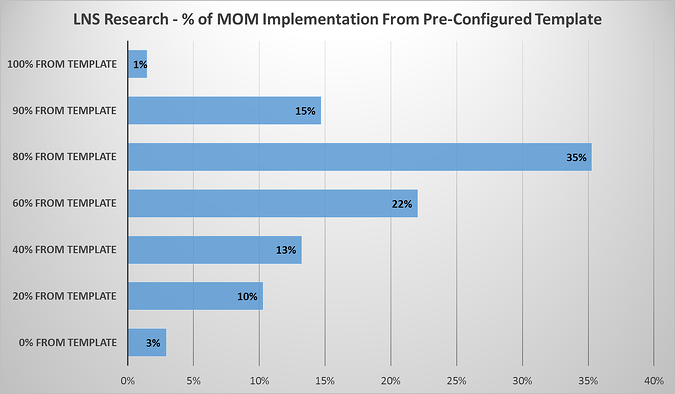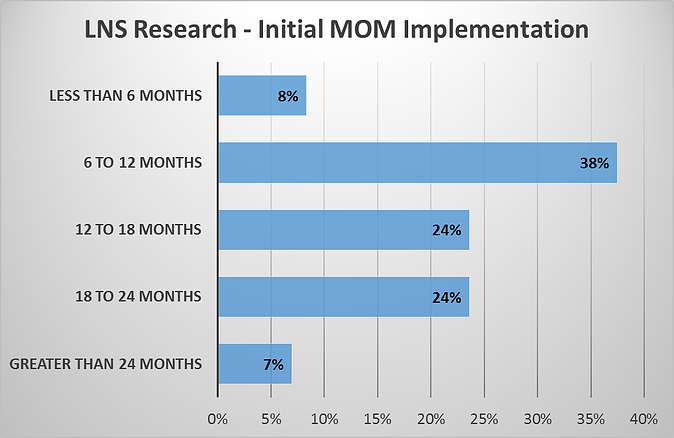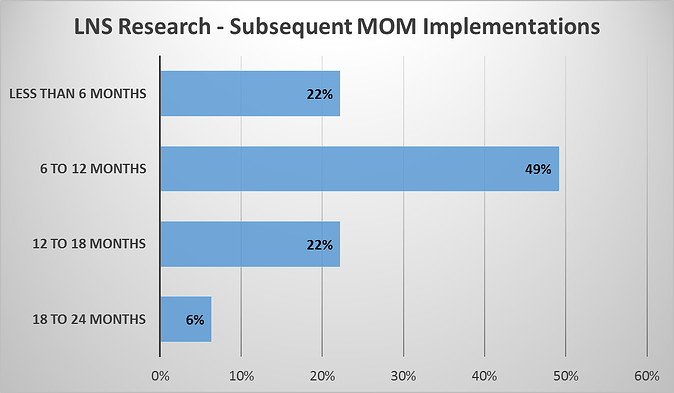The manufacturing operations management (MOM) software space is evolving in coverage areas and delivery methods. Along with increasingly modular architectures and the incorporation of technological advancements like mobile access, big data, and cloud capabilities, vendors are investing in industry-specific, pre-configured libraries and templates as part their manufacturing execution system (MES) and enterprise manufacturing intelligence / operational intelligence (EMI / OI) applications.
In our recent conversations with 20 of the top MOM software vendors, approximately half of them emphasized current and future investments in industry-specific templates.
The intent of this specialization is to increase the speed of implementation and time-to-value for customers and capture industry best practices. Indeed, in our MOM Best Practices Guide, LNS Research recommends that end-users work with a vendor that has specific industry expertise, and, to the extent possible, to take advantage of pre-configured templates and customize only when necessary.
But how effective are these pre-configured templates in today’s market? And what percentage of companies are choosing to implement a solution "out-of-the-box" as opposed to some level of customization?
Analyzing Data from Hundreds of Manufacturers
Launched a few months ago, the LNS Research MOM survey has been taken by 200+ manufacturing executives and decision makers, and dives deep into technological, process, and cultural concerns relevant to manufacturing operations in the pursuit of operational excellence. In the survey, we asked questions about the level of industry template vs. custom configuration implementations, along with the length of time companies are taking to implement those solutions.
Accelerating Time-to-Value in MOM Implementations
In one question, specific ranges were given for respondents to share the proportion of their manufacturing software implementation that was custom vs. pre-configured. This question was imited only to companies that had completed implementations. As shown in the graph below, the largest group of respondents (35%) used 80% of the vendor template and 20% customization.
It appears the 80/20 business rule applies here. While only 1% of respondents chose to implement solutions straight out of the box with no customization whatsoever, it’s important to note that over half of respondents (51%) used 80%-100% pre-configured functionality. The next highest response, at 22%, was 60% template/40% customization, meaning a total of 73% of companies are using 60%-100% of pre-configured template.

In another question, we asked companies that had completed some type of MOM software implementation about the time taken to implement. As the graph below illustrates, we see that 38% of initial implementations took companies 6-12 months to complete. Though the percentage of implementations that took less than 6 months is relatively low at 8%, we are seeing a trend of more rapid implementations with a smaller scope that are later scaled in manufacturing enterprise coverage and/or functionality over time.
How Pre-Configured Templates Affect Subsequent MOM Application Implementations
By looking at some of the longer timeframes on the graph we see that the majority of initial implementations are completed within the first 24 months. This is positive, because it’s often difficult to keep teams engaged on software projects beyond this timeframe. Plus, it’s important to start seeing results, of course.

When we look at subsequent implementations, we can see that once the groundwork and application templates are completed on the first implementation, the speed increases for additional implementations. Nearly half (49%) take only 6-12 months and 22% are taking less than 6 months, meaning a total of 71% are complete within a year or less.

Leveraging this Information for an Effective Solution Selection
The MOM software market is maturing, especially for the MES software and EMI / OI application space as vendors are offering increased industry-specific options and pre-configured templates and functionality. In our data, we’re finding a trend toward companies selecting out-of-the-box functionality when available, and that this is helping improve overall time-to-value and speed in subsequent application implementations.
Manufacturing executives looking to find vendors that offer the industry-specific experience and pre-configured functionality best suited for their business can find out more information LNS Research's Manufacturing Operations Management Solution Selection Guide. The guide breaks down 20 leading vendors across a number of dimensions, providing executives and technology decision makers with everything needed to make a shortlist of potential solutions providers.
